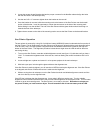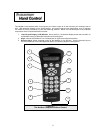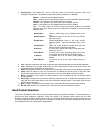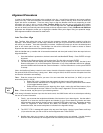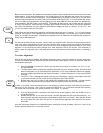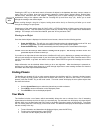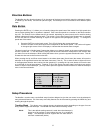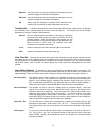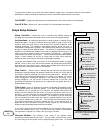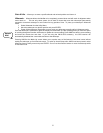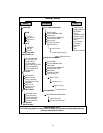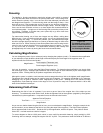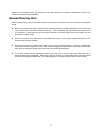20
EQ North
Used to track the sky when the telescope is polar aligned using an
equatorial wedge in the Northern Hemisphere.
EQ South
Used to track the sky when the telescope is polar aligned using an
equatorial wedge in the Southern Hemisphere.
Off
When using the telescope for terrestrial (land) observation, the
tracking can be turned off so that the telescope never moves.
Tracking Rate In addition to being able to move the telescope with the hand control buttons, the NexStar
will continually track a celestial object as it moves across the night sky. The tracking rate can be changed
depending on what type of object is being observed:
Sidereal
This rate compensates for the rotation of the Earth by moving the
telescope at the same rate as the rotation of the Earth, but in the
opposite direction. When the telescope is polar aligned, this can
be accomplished by moving the telescope in right ascension only.
When mounted in Alt-Az mode, the telescope must make
corrections in both altitude and azimuth.
Lunar
Used for tracking the moon when observing the lunar landscape.
Solar
Used for tracking the Sun when solar observing.
View Time-Site - Displays the last saved time and location information as well as other relevant time-site
information like time zone, daylight saving and local sidereal time. Local sidereal time (LST) is useful for knowing
the right ascension of celestial objects that are located on the meridian at that time. If you are using the optional
CN16 GPS module, View Time-Site will always display the current information downloaded from the GPS
receiver.
User Defined Objects - The NexStar can store up to 400 different user defined objects in its memory. The
objects can be daytime land objects or an interesting celestial object that you discover that is not included in the
regular database. There are several ways to save an object to memory depending on what type of object it is:
Save Sky Object: The NexStar stores celestial objects to its database by saving its right ascension and
declination in the sky. This way the same object can be found each time the telescope is
aligned. Once a desired object is centered in the eyepiece, simply scroll to the "Save Sky
Obj" command and press ENTER. The display will ask you to enter a number between 1-
200 to identify the object. Press ENTER again to save this object to the database.
Save Land Object: The NexStar can also be used as a spotting scope on terrestrial objects. Fixed land
objects can be stored by saving their altitude and azimuth relative to the location of the
telescope at the time of observing. Since these objects are relative to the location of the
telescope, they are only valid for that exact location. To save land objects, once again
center the desired object in the eyepiece. Scroll down to the "Save Land Obj" command
and press ENTER. The display will ask you to enter a number between 1-200 to identify the
object. Press ENTER again to save this object to the database.
Enter R.A. - Dec: You can also store a specific set of coordinates for an object just by entering the R.A. and
declination for that object. Scroll to the "Enter RA-DEC " command and press ENTER.
The display will then ask you to enter first the R.A. and then the declination of the desired
object.
GoTo Object: To go to any of the user defined objects stored in the database, scroll down to either GoTo
Sky Obj or Goto Land Obj and enter the number of the object you wish to select and
press ENTER. NexStar will automatically retrieve and display the coordinates before
slewing to the object.



